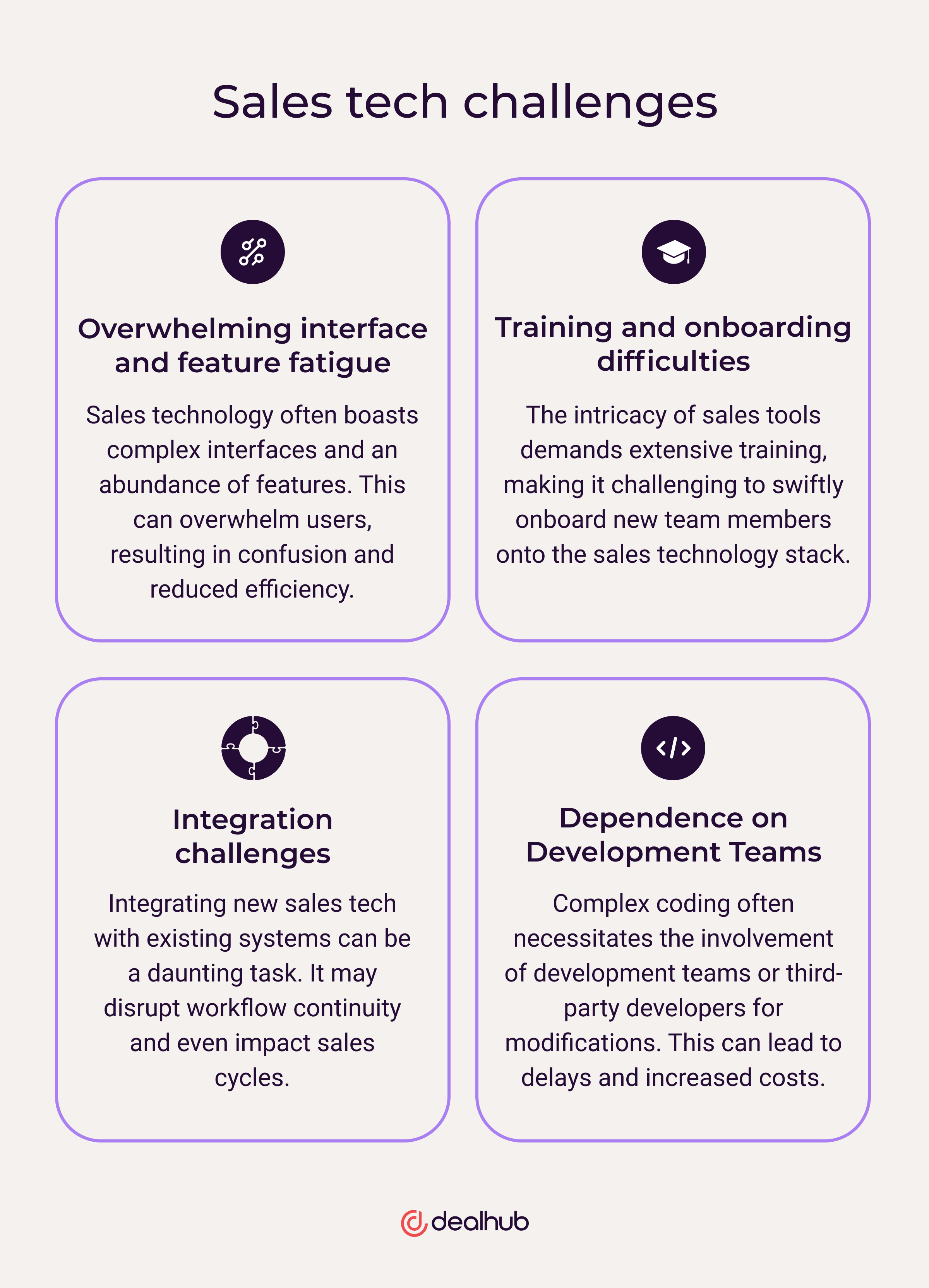Furthermore, a recent study by CSO Insights shows that inside sales, a sector heavily reliant on sales tech, is rapidly growing. Interestingly, only 33% of an inside sales professional’s time is spent actively selling. This problem highlights the critical need to balance functionality and simplicity in sales technology.
In this article, we’ll explore strategies to strike this balance, ensuring sales tools empower rather than burden the sales process. From understanding the evolving landscape of sales tech to harnessing its potential without getting lost in complexity, we hope to equip Sales Ops professionals with the insights needed to navigate this dynamic domain.
The growing complexity of sales technology
The evolution of sales technology has been both rapid and profound, fundamentally affecting how sales are piloted. From the days when the fax machine was considered cutting-edge in the 1990s to the current era of advanced digital tools, sales technology has undergone significant transformation. Modern SaaS companies have been at the forefront of this revolution, marking a shift from traditional methods to more sophisticated, tech-driven strategies.
These advancements in sales technology over the past few years, particularly during the pandemic, have been notable. The shift to virtual sales and an anytime/anywhere work environment necessitated a change in the way sales are conducted. This period saw an increased reliance on technologies like automation and AI, which helped streamline processes and enable sales professionals to respond more rapidly and personalize their approach to meet evolving customer expectations.
However, integrating these advanced technologies has not been without challenges. The complexity of modern sales tools can impact user adoption and efficiency. For instance, the shift from tools designed for aggressive message broadcasting to those focused on effective communication and deep engagement represents a significant change in the salesperson’s toolkit. This evolution indicates a move towards more efficient and powerful systems but also brings to light the challenges sales teams face in adapting to these sophisticated tools.
Real-world examples have shown that while these technologies can enhance sales capabilities, they also require sales teams to adapt their strategies and continuously update their skills to stay relevant and efficient in a tech-driven sales environment. The key challenge lies in leveraging these advanced tools while maintaining simplicity and ease of use to ensure high adoption rates and efficient sales processes.
Balancing functionality and simplicity
Finding the right balance between functionality and simplicity in sales technology is challenging. On one hand, advanced functionalities are vital to meet diverse sales challenges; on the other, simplicity ensures these tools are accessible and user-friendly. The key lies in embracing user-centric design principles, which prioritize the user’s needs and experiences in developing and implementing these tools.
User-centric design in sales tech stacks means tools are intuitive, easy to navigate, and tailored to the user’s workflow, reducing the learning curve and enhancing overall efficiency. However, simplicity in design does not mean a lack of sophistication. It means presenting complexity in a way that is understandable and manageable. This approach ensures that even the most sophisticated functionalities are offered in a manner that is accessible and useful to the salesperson. As Steve Jobs would have said, “Simple can be harder than complex: You have to work hard to get your thinking clean to make it simple.”
Complex tools that are hard to use can lead to low adoption rates, frustration, and ultimately, a decline in productivity. Conversely, overly simplified tools might lack the necessary features to address sales challenges effectively. Equilibrium is critical in this scenario. It’s about providing powerful capabilities in a form that sales professionals can readily embrace and utilize to their full potential, thereby enhancing both their performance and the customer experience.
Key challenges

Several challenges often emerge with sales tech:
- Overwhelming interface and feature fatigue: Sales technology usually comes with complex interfaces and an overload of features, leading to confusion and decreased efficiency.
- Training and onboarding difficulties: The intricacy of these tools necessitates extensive training, which can make it challenging to quickly onboard new sales team members onto a company’s sales technology stack.
- Integration challenges: Integrating new sales tech with existing systems can be cumbersome, disrupting workflow continuity and sometimes even sales cycles.
- Dependence on development teams: Complex coding often requires the involvement of a development team or third-party developers for changes, leading to delays and increased costs.
Strategies to overcome these challenges include simplifying user interfaces, developing more intuitive training materials, ensuring compatibility with existing systems, and adopting no-code solutions to reduce dependency on external developers.
Selecting tools that empower sales teams
Selecting the right tools for sales teams hinges on several criteria, aimed at enhancing operations without complicating them:
Prioritizing user experience
User-friendly tools with intuitive interfaces encourage higher adoption rates. For instance, CRM platforms with clean, navigable dashboards are more likely to be embraced by sales personnel.
Scalability and adaptability
Tools should not only meet current needs but also adapt to future growth. For example, a CRM that scales up with increased customer data and integrates new features seamlessly proves invaluable.
Ease of integration
Seamless integration with existing systems, like email or accounting software, ensures uninterrupted workflows and productivity.
Benefits of no-code solutions
No-code platforms, simplify customization without extensive IT involvement, offering flexibility and independence to sales teams.
By focusing on these aspects, sales tools can significantly improve operational efficiency without adding unnecessary complexity, ultimately contributing to a smoother, more productive sales process.
Overcoming complexity

To overcome the complexity inherent in sales technology, consider these strategies:
- Effective training programs: Implement comprehensive training programs that are tailored to different learning styles within the sales team. For example, a blend of hands-on workshops and digital tutorials can cater to varied preferences and be part of a sound sales strategy.
- Leveraging automation: Utilize automation to simplify routine tasks, such as data entry or lead tracking, which can significantly reduce the complexity of sales processes.
- Feedback-driven optimization: Regularly collect and act on feedback from sales teams to refine and optimize the use of sales technology. This ongoing process can involve adjusting tool features or workflows based on user experiences.
When effectively applied, these strategies have shown significant improvements in managing complex sales tech, as evidenced in various case studies where sales teams have reported increased efficiency and user satisfaction.
Sales technology success stories
SourceScrub is an excellent example of how adopting user-friendly sales tools can lead to significant improvements in efficiency and sales process management. In this case, integrating CPQ software, document generation, and contract management tools enabled SourceScrub to handle a high volume of leads more effectively and improve their quote sending and revision process, resulting in a 94% increase in efficiency. Additionally, utilizing DealHub’s DealStream data for tracking buyer engagement was instrumental in strategic selling and faster deal closures.
Similar success can be seen in other renowned companies. For instance, Salesforce, known for its CRM solutions, has helped businesses like Spotify and Amazon Web Services streamline customer interactions and sales activities. Another example is HubSpot, which has assisted companies like Subaru in enhancing their marketing and sales efforts through its integrated marketing tools.
These examples underscore the importance of selecting tools that meet a business’s specific needs and prioritize ease of use and integration with existing workflows.
Prioritize user-friendly sales tech
Achieving a balance between functionality and simplicity is crucial in sales technology. The balance does not solely depend on having the appropriate tools but also on ensuring that these tools are easily usable, intuitive, and smoothly integrated into existing workflows. Sales Ops leaders are encouraged to prioritize solutions that embody this equilibrium, focusing on user-friendly, no-code options such as DealHub to automate the quote-to-revenue process. These tools are designed to empower sales teams, enabling them to focus on what they do best – selling.
Looking ahead
With advancements in technology, sales tools are becoming more sophisticated yet user-friendly. The integration of these technologies promises a future where sales processes are more efficient, data-driven, and customer-centric. This evolution in sales tech streamlines operations and empowers sales teams to achieve greater revenue growth.
As sales technology continues to evolve, the priority for Sales Ops leaders should be clear: embrace fully integrated no-code solutions that strike the right balance between advanced functionality, and ease of use, to manage the full customer lifecycle from end to end. By adopting such solutions, organizations can establish a scalable model that equips their teams with the necessary tools to thrive, ultimately driving business growth and success.








